Whether your watch was given to you as a gift or you’re looking to buy a Tissot watch, you’d expect to get the real one.
But unfortunately, fake watches can be found anywhere these days. And those watchmakers keep getting better at forging fakes.
So, how could you tell if your Tissot watch is genuine?
The good news is, there are many ways to confirm the watch’s legitimacy.
Keep reading to learn:
- 9 simple steps to spot a fake Tissot watch.
- Proven signs that your Tissot watch is genuine.
- Essential tips on what to do with a fake Tissot watch.
- And more…
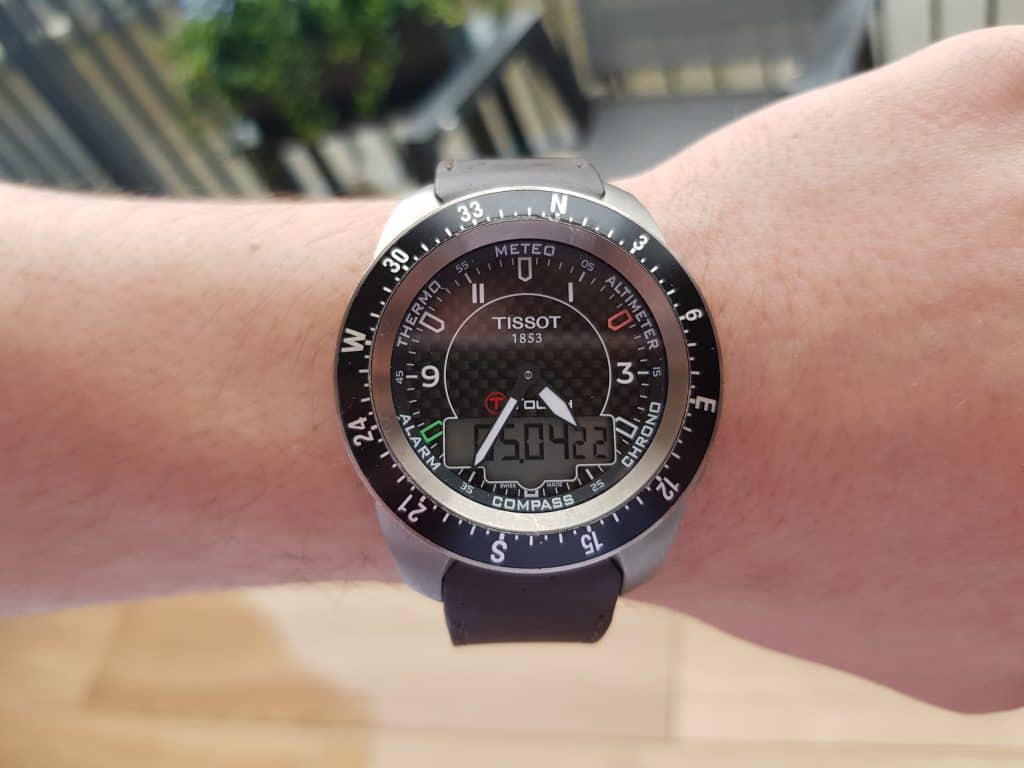
Table of Contents
9 Simple Steps To Spot A Fake Seiko Watch
Step 1: Watch out for typos
This very first step can be painfully obvious.
But funnily enough, a lot of counterfeit products still mess it up. And I’m referring to the brand name itself.
You see, fakes tend to misspell ‘Tissot’ in various ways. And most of them are wrong.
You’ll most commonly see the brand name with only 1 letter ‘s’: Tisot. This is a massive giveaway that your Tissot watch is fake.
Though, in other cases, some fakes will write ‘Tissott‘ or ‘Tisott‘ too.
This is why you should always watch out (pun intended) for typos.
Step 2: The pricing
As a world-famous brand, Tissot watches can be pretty expensive.
A new Tissot watch typically ranges between $500 and $3,000.
So when you’re about to buy a brand new Tissot watch, you should expect to see the price within the above range.
Of course, when you’re buying a Tissot watch, you know what model you want, so you can be even more specific regarding price.
Now that you have the retail price, as well as the price you’re about to pay, you can apply an age-old rule:
‘If it’s too good to be true, it probably is.‘
But what about second-hand Tissots?
However, you should also know that Tissot watches eventually lose their value. Specifically, a watch loses 10-20% of its value annually.
And after about 3 years, the devaluation tends to stabilize. But at that point, it has already lost between 30% and 60% of its value.
So unlike when you buy a brand new Tissot, a second-hand piece can be much cheaper. Even to the point where you may get 30% off.
But once again, you should use common sense here.
When someone sells their beloved Tissot watch, they don’t look up how much it depreciated. Instead, they slap on a price they think the watch is worth.
Again, remember the rule: ‘If it’s too good to be true, it probably is‘.
You might also like: Is Tissot A Luxury Watch Brand?
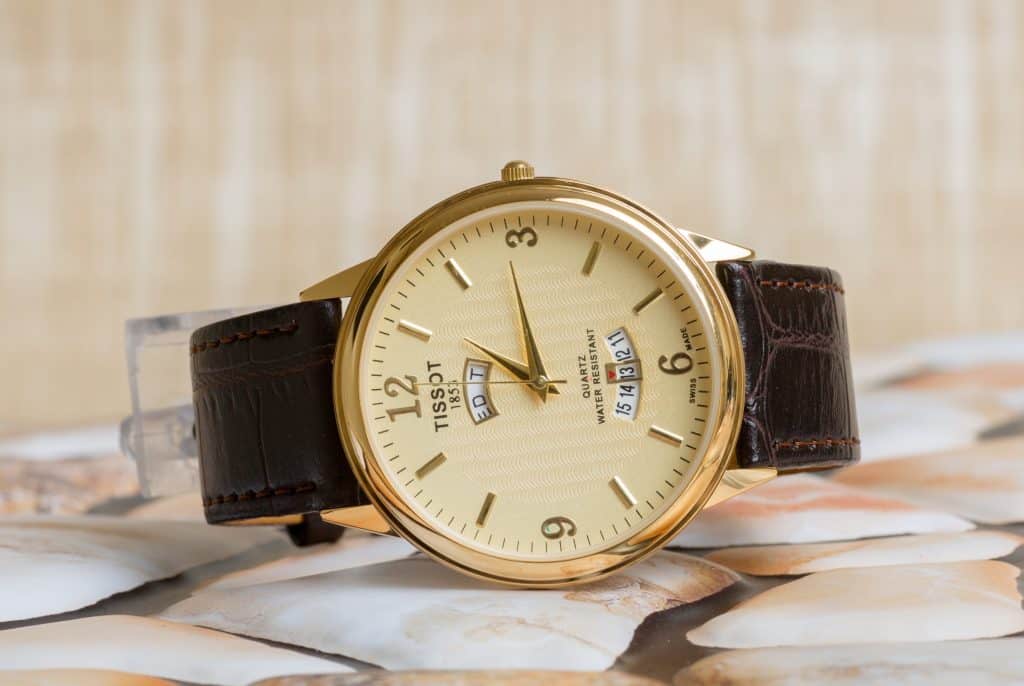
Step 3: Check the weight
Just as I mentioned above, Tissot watches only use the best materials.
They typically use stainless steel, and, to be more specific, the 316L stainless steel alloy. This is the industry standard for high-quality watches.
But some higher-end models may even carry 18K gold.
And it’s not only the metals; you can expect their leather straps to be of high quality too.
With high-quality materials, you really feel the weight of it all. Just hold a luxury timepiece in one hand and a cheap one in the other. The difference is as clear as night and day.
Now, a fake Tissot watchmaker can’t afford any of those expensive materials. Instead, they use cheap alternatives.
So in a way, you can really feel the validity of the watch.
Plus, if you know which model you have on your hands, you can verify its weight on Tissot’s official website.
Some of their current models are listed there. And they contain details about the watch, such as the specific weight, length, color, and more.
Watch out for scratches on the crystal
Besides the watch’s weight, you should also see if there are markings on the crystal.
This is the piece of ‘glass’ that covers the dial.
Tissot typically uses either of 2 materials: mineral glass or sapphire crystal.
Once again, you can verify beforehand what material your desired model has.
In the case of mineral glass, it’s okay to see some scratches.
Of course, you’ll have to judge whether it devalues the watch, but with mineral glass, scratches happen.
With a sapphire crystal, it’s a completely different story.
This material can only be scratched by diamonds. So if you see scratches on the glass face of a Tissot watch that’s supposed to have a sapphire crystal, you’ll instantly know it’s a fake.
However, scratches on the band, case, or other parts of the watch are fairly typical for second-hand Tissot watches.
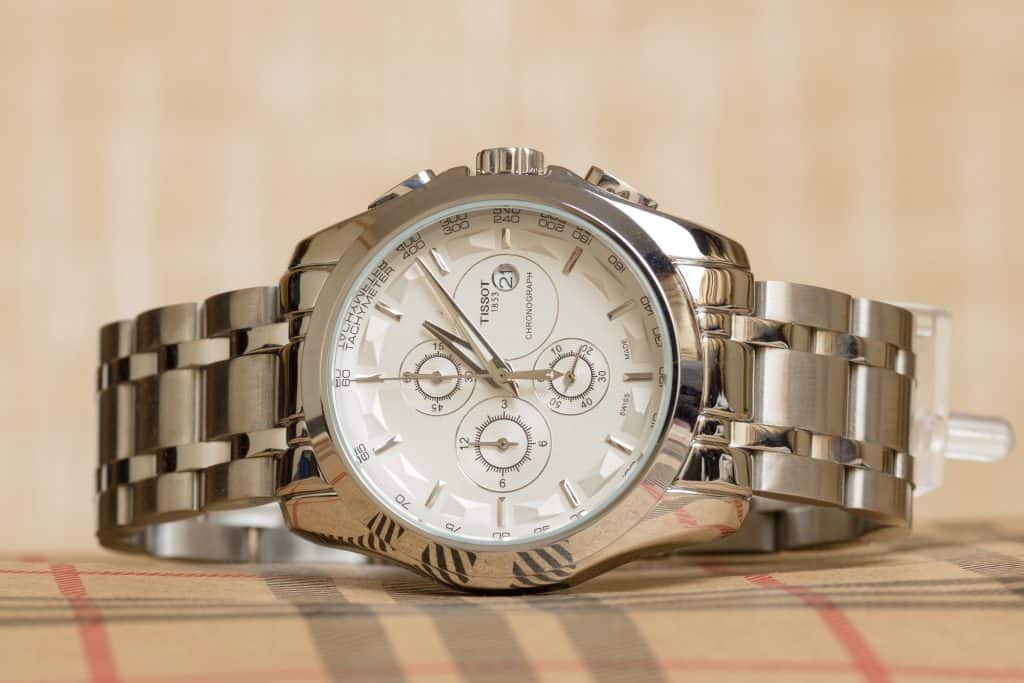
Step 4: Examine the product box
Like many official brands, Tissot watches come with a fancy box upon purchase.
First, the box should be of good quality as well. Meaning, you shouldn’t spot any dents or other damages on it.
Of course, this doesn’t apply to second-hand watches. If that’s the case, you can expect the box to be slightly damaged.
Anyway, there should be a manual inside the product box too. It guides watch owners on how to properly use the watch and maintain it.
Not to mention, if the box or manual is missing, that can highly devalue the watch itself.
However, most fake watch sellers forget to include this part.
I mean, why would they go through the effort of writing down a guide? Especially if they’re only selling a fake watch, right?
But let’s say your Tissot watch comes with a handy manual.
Well, the inspection doesn’t stop there.
What you should do next is read the manual.
I know that can be boring for some people. But the thing is, fake Tissot manuals might contain typos or grammatical errors.
Those are huge signs that your Tissot watch is a fake.
“But what if there’s no spelling mistakes or poor grammar?”
Well, all there’s left to check is if the content makes sense.
For example, I could write this entire article with a bunch of random information. It might seem good at first glance, but you’ll quickly realize it’s full of unnecessary details.
The point is, manuals should be helpful for watch owners.
So, if your booklet doesn’t make sense, then your Tissot watch isn’t real.
Step 5: Examine the crown engraving
Every detail matters.
That’s why your Tissot watch should have its iconic “T” logo engraved on the crown.
However, if the letter “T” sticks out like it’s glued on top of the crown, that means the logo isn’t carved. Now that’s a huge sign that your Tissot watch is a fake.
And since we’re talking about engravings, you can also check the ones on the watch face.
The brand name “Tissot” should be carved neatly on the watch.
However, fake watchmakers tend to mess up here.
Meaning, you might spot letters looking thicker or smaller than usual. The letters might look uneven too.
You see, this will never happen with an original Tissot watch. That’s because the letterings on their watches are perfectly carved. Just like many other big brands, such as real Seikos.
Step 6: Smooth hand and crown movement
Try winding up your Tissot watch.
Now, a real one should have smooth hand movement. You shouldn’t feel any bumps with the hands at all. This means it should flow smoothly until you stop winding it up.
And the same goes for the crown.
When you’re winding it up, the crown should be easy to adjust.
Meanwhile, fake Tissot watches are harder to wind than authentic watches. They may be a little wobbly, or they feel rugged.
If you feel any resistance when winding the watch, it’s a sign of one of 2 things:
- The watch is fake.
- The watch is in need of a service.
A Tissot service isn’t the cheapest either, so it may be worth it to find another seller.
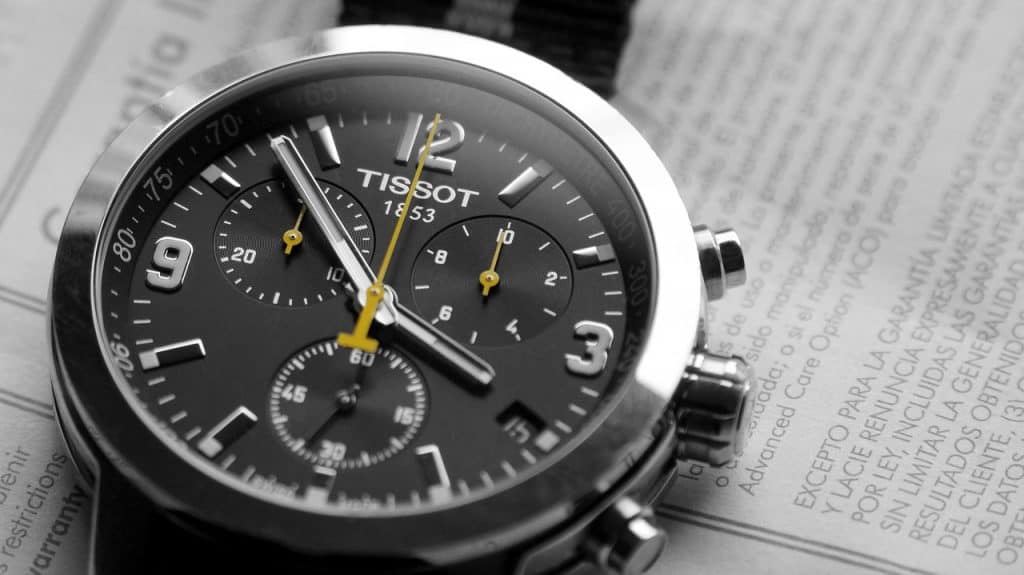
Step 7: Observe how it glows
The numbers and hour markings on some Tissot watch models should glow in the dark.
That happens when the watch’s markings are made with a material called “Tritium.” According to researchers, it’s a radioactive version of hydrogen.
And it’s what makes watches glow.
But here’s the thing, tritium is highly expensive. That’s why fake watchmakers won’t bother using that on a fake Tissot watch.
That said, try turning off the lights in your room. Then, see if your watch gives off that eye-catching glimmer.
If it does, that’s strong proof that your Tissot watch is genuine.
Meanwhile, most counterfeit watches won’t glow at all.
But what if your Tissot watch does glow… just not bright enough?
Well, tritium does have a half-life of about 12,3 years. In other words, after 12.3 years, only half of the original Tritium levels are still present.
And with half of the levels present, you won’t get as bright of a glow.
So if the watch glows only a little, inquire about the watch’s age. If it’s an older watch, it’s no issue. But if a supposedly brand-new Tissot has a very soft glow, it’s a sign of it being fake.
While a soft glow isn’t an inherent giveaway, you should still be suspicious.
Step 8: Questionable markings on the watch face
Professional brands like Tissot treat their watches with utmost care.
That means you won’t find any dirt or scratches on the watch’s face, especially if it’s brand new.
But, of course, the exception applies to second-hand watches. After all, they can be damaged by the previous owner.
However, you should also know that fake watchmakers don’t have time to be careful with their crafts. And that’s why you might spot fingerprints on the watch’s face.
Not just that, you might see dirt or minor scratches on there as well.
Now, to make this easier, you can use a magnifying glass to examine the details of your Tissot watch.
Alternatively, you can also try checking it with your phone camera. However, it might not work if the zoom feature blurs out the details.
With this trick, you can also check the other parts of the watch.
For example, the watch’s numbers should be evenly carved. The same thing applies to the pointers.
If one of the hand pointers seems thicker or thinner than the rest, that’s another sign of fake Tissot watches.
And in case you need visual guidance, you might find this video helpful:
Step 9: Verify the serial number
Newer models of Tissot watches have a 9-digit alphanumeric code.
These numbers indicate the watch’s place of production. Also, each code should start with the letters ‘WS’, which stands for: ‘WATCH-SECUR.’
With these serial numbers, it’s easier to spot a fake Tissot watch.
After all, counterfeits don’t have a way of finding out the official serial numbers from Tissot.
So if you have doubts, you should always look for the serial number first. You’ll find these digits on the case back of your watch.
Once you have the number, you can get in touch with Tissot’s official customer service.
From there, they can help you trace the location of where your watch model came from.
However, if they can’t find anything with the digits you provided, that only means one thing. Your Tissot watch is a fake.
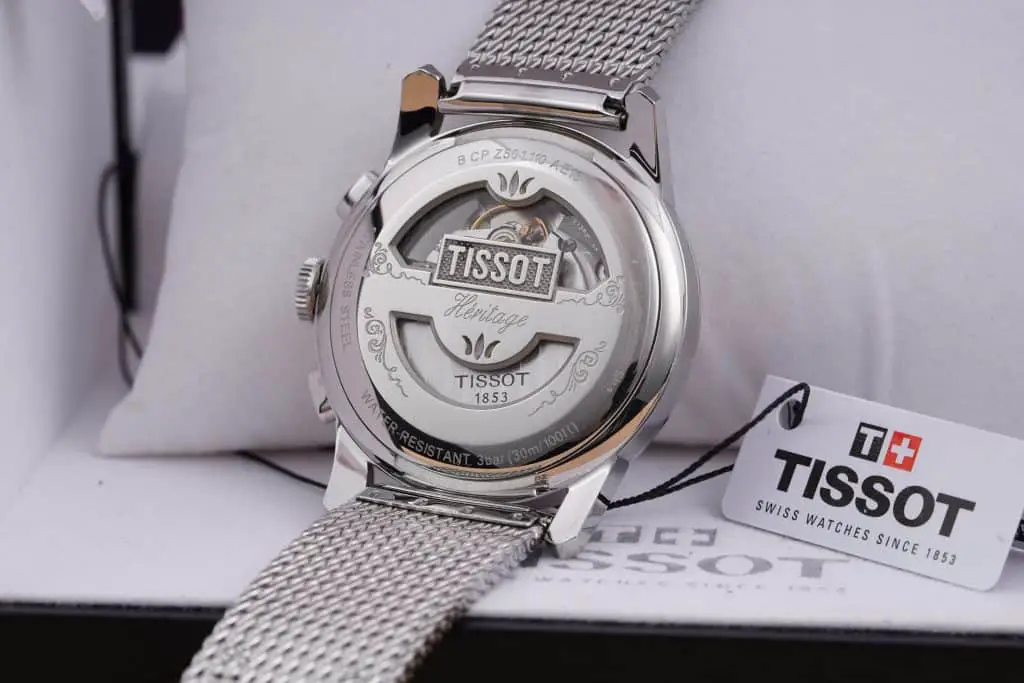
“What if there’s a code on my watch, but it’s not 9 digits?”
In that case, you might have an older Tissot watch model in your hands.
But the thing is, Tissot watches from the 1960s have confusing serial numbers. And they appear in various parts of the watch too.
Thanks to that, most people don’t know what their code actually means.
Plus, serial codes of older Tissot watches can be random too.
For example, Tissot watches from 1976 may have 7-digit codes. Meanwhile, the ones from 1977 only have 5 digits.
With this information, fake watch sellers can use that as an excuse for their incorrect serial numbers. This allows them to deceive unsuspecting buyers.
However, spotting these antique Tissot watches is easy. You can quickly tell how different their design looks compared to modern Tissot watches.
Once you know about this, fake watch sellers can’t trick you at all.
That aside, most people prefer buying the latest models, right? So, if you expected a new watch, then you should see a 9-digit alphanumeric code instead.
This also applies to any second-hand Tissot watch nowadays.
But if you still have doubts, then your best shot is to call Tissot’s company.
Only they can verify the watch’s serial code for you.
What to do if you have a fake Tissot watch
It’s disappointing to find out that your Tissot watch is a counterfeit. And it’s understandable if you want to do something right about it.
In that case, it’s good to know that the company takes fakes very seriously. This means that Tissot is constantly hunting down these pirates.
Plus, they’re always ready to sue those selling fake Tissot products.
Now, this gives you the option to cooperate with Tissot. You can surrender the counterfeit watch and report the details of how, when, and where you got the fake watch from.
This will aid their investigation to shut down another place that sells fake Tissot watches.
Tissot company also warns that fake watches might contain harmful materials in them. In their official post, Tissot encourages people to stop using counterfeit watches for health reasons.
However, if you’re expecting to get a refund, you can only demand that from the seller.
3 helpful tips in case you bought a fake Tissot watch
If you’re an online shopper using PayPal, here are 3 ways you can try to get your money back:
- Request a refund through the app.
- Start a dispute claim by calling PayPal.
- File a chargeback case with your bank.
If you paid the seller through an option called: ‘Friends and Family‘, getting a refund on PayPal can be easier.
Just open your app and contact customer support for help.
However, if you used the ‘Goods and Services‘ option to pay, then PayPal will instruct you to file a dispute claim. This escalates into a series of investigations.
Basically, PayPal will talk to the seller and to you to understand the situation. And you have to keep up with it until you win the case.
Additionally, PayPal might ask for photos of the watch as evidence that it’s a fake.
Now, if all else fails, then your last hope is your bank.
Some banks will let you file a chargeback request if you report a fraudulent transaction. And in this case, you got scammed by a fake watch seller.
With this method, the bank will forcibly try to get your money back from the account you sent it to.
However, this process can take a long time depending on your bank. Plus, there’s no guarantee that it will work.
